
Am Fam Physician. 2013;88(6):380-386
Author disclosure: Dr. Ebell is cofounder and editor-in-chief of Essential Evidence Plus, published by Wiley-Blackwell. Dr. Grad has no relevant financial affiliations.
This is the second annual summary of top research studies in primary care. In 2012, through regular surveillance of more than 100 English-language clinical research journals, seven clinicians identified 270 studies with the potential to change primary care practice, called POEMs, or patient-oriented evidence that matters. These studies were then summarized in brief, structured critical appraisals and e-mailed to subscribers, including members of the Canadian Medical Association. A validated tool was used to obtain feedback from these physicians about the clinical relevance of each POEM and the benefits the physicians expected for their practice. The 20 identified research studies rated as most relevant cover common topics such as diabetes mellitus, cardiovascular disease prevention, infectious disease, musculoskeletal disease and exercise, cancer screening, and women's health.
Many journals create lists of the most important articles or studies for their readers, and last year American Family Physician published its first such collection1; this article is the second annual summary of top research studies in primary care. For 2012, seven clinicians with expertise in primary care and evidence-based medicine performed monthly surveillance of more than 100 English-language clinical research journals.2 Out of more than 20,000 studies published in these journals, the clinicians identified 270 studies with the potential to change primary care practice, called POEMs, or patient-oriented evidence that matters.3 These studies were then summarized in brief, structured critical appraisals.
The most useful information is highly relevant (leading to improved patient outcomes) and highly valid (the study was well-designed and without important biases). The term “patient-oriented” refers to outcomes that are important to patients, such as decreased morbidity and mortality, and improved quality of life, rather than disease-oriented outcomes, such as changes in physiologic variables (e.g., serum glucose levels, glomerular filtration rate, electrocardiographic findings). The clinicians who select the POEMs prioritize studies that could change practice over those that merely confirm existing practice.
Since 2005, members of the Canadian Medical Association have had the option of receiving a daily e-mail containing the most recent POEM. Each time they receive a POEM, they can rate it with a validated tool called the Information Assessment Method. The tool addresses cognitive impact, clinical relevance, use in practice, and, if implemented, expected health benefits.4 Of the original 270 studies, the 30 that rated highest for relevance were reviewed, and any that were not based on original research (e.g., a synopsis of a practice guideline) were excluded. This left 20 POEMs, which were then grouped into clinical categories. In the final list of the top 20 POEMs, at least 56% of raters considered each POEM “totally relevant” and less than 15% considered each “not relevant.” Each POEM was rated by 500 to 1,200 physicians.
We believe that this list based on the ratings of practicing physicians is more valid and relevant than simply having a group of editors or experts choose top articles based on their personal opinion. This article provides the clinical question and bottom-line answer for each POEM, organized by topic and followed by a brief discussion.
Diabetes Mellitus
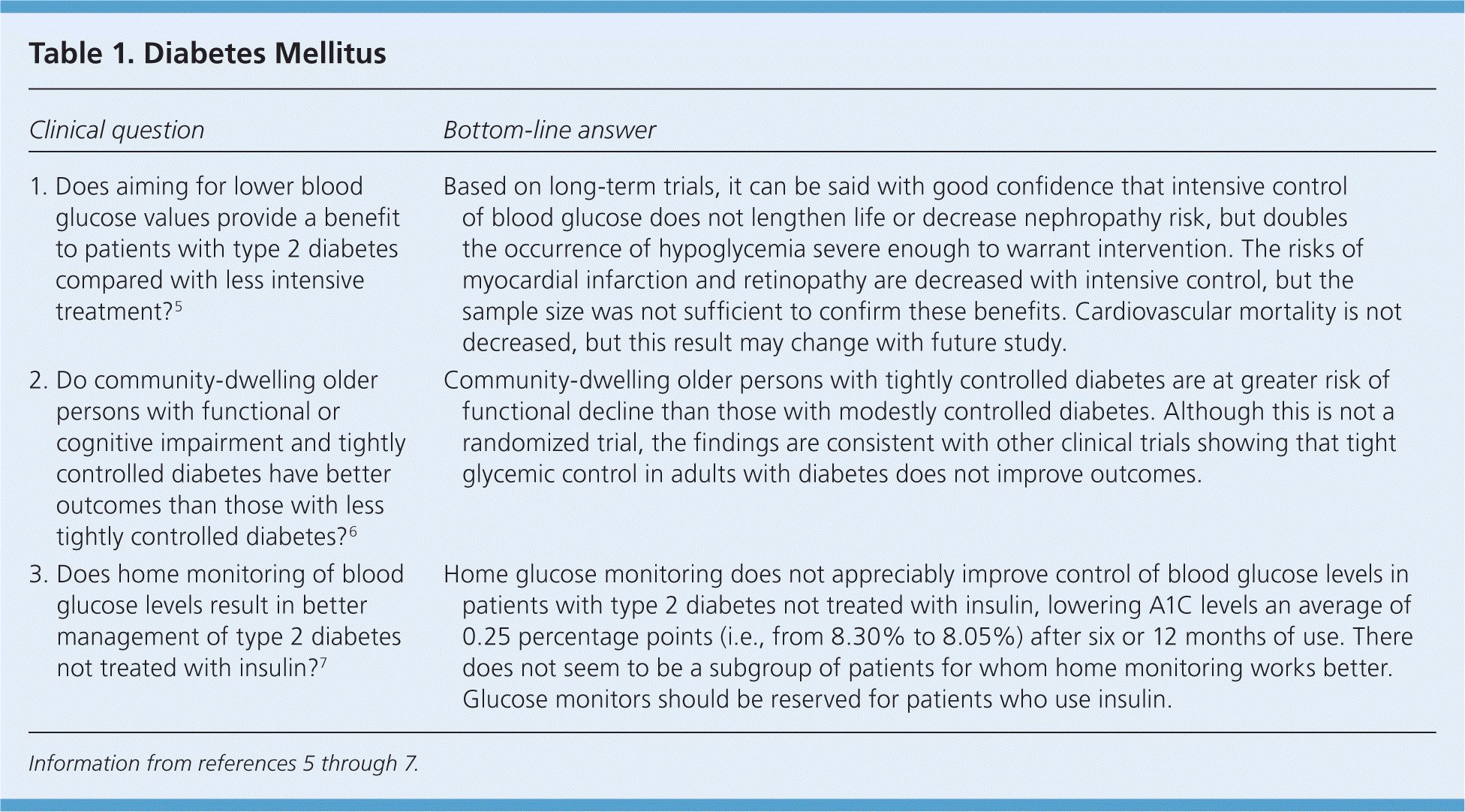
| Clinical question | Bottom-line answer |
|---|---|
| 1. Does aiming for lower blood glucose values provide a benefit to patients with type 2 diabetes compared with less intensive treatment?5 | Based on long-term trials, it can be said with good confidence that intensive control of blood glucose does not lengthen life or decrease nephropathy risk, but doubles the occurrence of hypoglycemia severe enough to warrant intervention. The risks of myocardial infarction and retinopathy are decreased with intensive control, but the sample size was not sufficient to confirm these benefits. Cardiovascular mortality is not decreased, but this result may change with future study. |
| 2. Do community-dwelling older persons with functional or cognitive impairment and tightly controlled diabetes have better outcomes than those with less tightly controlled diabetes?6 | Community-dwelling older persons with tightly controlled diabetes are at greater risk of functional decline than those with modestly controlled diabetes. Although this is not a randomized trial, the findings are consistent with other clinical trials showing that tight glycemic control in adults with diabetes does not improve outcomes. |
| 3. Does home monitoring of blood glucose levels result in better management of type 2 diabetes not treated with insulin?7 | Home glucose monitoring does not appreciably improve control of blood glucose levels in patients with type 2 diabetes not treated with insulin, lowering A1C levels an average of 0.25 percentage points (i.e., from 8.30% to 8.05%) after six or 12 months of use. There does not seem to be a subgroup of patients for whom home monitoring works better. Glucose monitors should be reserved for patients who use insulin. |
Studies 1 and 2 (Table 15–7 ) address the evolving evidence regarding the lack of benefit of intensive glucose control for persons with type 2 diabetes. The first study is a meta-analysis of 14 studies with 28,614 patients. The study asked whether there was sufficient “information size” to confirm various benefits of intensive control.5 There was no reduction in all-cause mortality, cardiovascular mortality, or nephropathy, but the risk of severe hypoglycemia doubled. The second study is an observational study that examined a group of community-dwelling older persons with functional or cognitive impairment and tightly controlled diabetes.6 The results showed a weak association between blood glucose levels and outcomes; those with an A1C level less than 8% were at somewhat greater likelihood of functional decline.
Study 3 is a meta-analysis of six randomized controlled trials including 2,552 patients with type 2 diabetes not treated with insulin. The study compared routine daily home monitoring of blood glucose levels with no monitoring.7 The results showed a clinically nonsignificant reduction in A1C levels of 0.25 percentage points with home monitoring, and also found that monitoring causes discomfort and incurs a significant financial burden for patients. Although patients may benefit from using a monitor to check their blood glucose levels on “sick days,” that has not been systematically studied.
Cardiovascular Disease
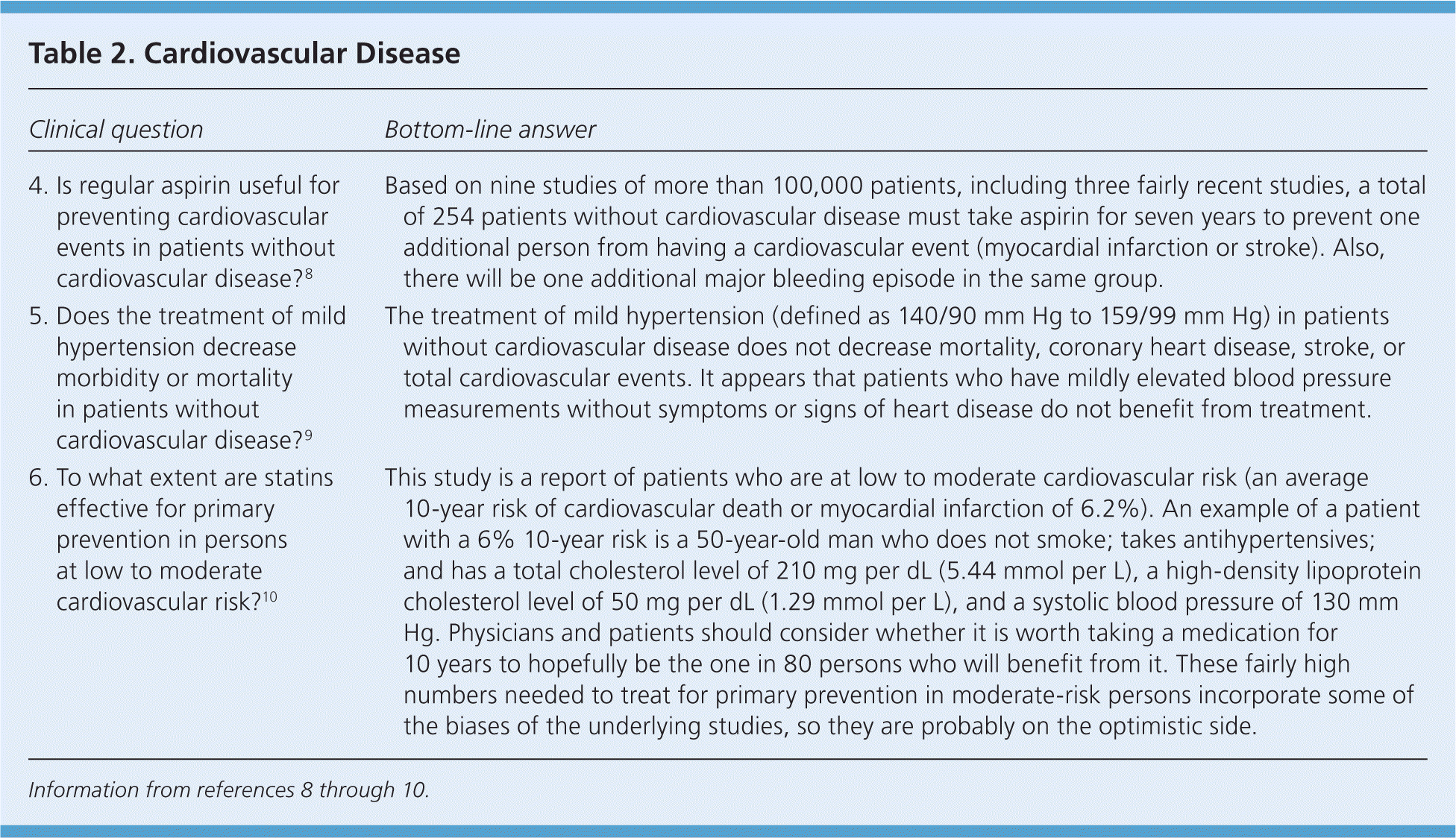
| Clinical question | Bottom-line answer |
|---|---|
| 4. Is regular aspirin useful for preventing cardiovascular events in patients without cardiovascular disease?8 | Based on nine studies of more than 100,000 patients, including three fairly recent studies, a total of 254 patients without cardiovascular disease must take aspirin for seven years to prevent one additional person from having a cardiovascular event (myocardial infarction or stroke). Also, there will be one additional major bleeding episode in the same group. |
| 5. Does the treatment of mild hypertension decrease morbidity or mortality in patients without cardiovascular disease?9 | The treatment of mild hypertension (defined as 140/90 mm Hg to 159/99 mm Hg) in patients without cardiovascular disease does not decrease mortality, coronary heart disease, stroke, or total cardiovascular events. It appears that patients who have mildly elevated blood pressure measurements without symptoms or signs of heart disease do not benefit from treatment. |
| 6. To what extent are statins effective for primary prevention in persons at low to moderate cardiovascular risk?10 | This study is a report of patients who are at low to moderate cardiovascular risk (an average 10-year risk of cardiovascular death or myocardial infarction of 6.2%). An example of a patient with a 6% 10-year risk is a 50-year-old man who does not smoke; takes antihypertensives; and has a total cholesterol level of 210 mg per dL (5.44 mmol per L), a high-density lipoprotein cholesterol level of 50 mg per dL (1.29 mmol per L), and a systolic blood pressure of 130 mm Hg. Physicians and patients should consider whether it is worth taking a medication for 10 years to hopefully be the one in 80 persons who will benefit from it. These fairly high numbers needed to treat for primary prevention in moderate-risk persons incorporate some of the biases of the underlying studies, so they are probably on the optimistic side. |
The common theme of these three POEMs is that physicians may be overtreating cardiovascular disease if patients at low or moderate risk of disease are treated as intensively as those at high risk. Compared with high-risk patients, lower-risk patients experience the same costs and potential harms with a lower probability of benefit. Study 4 (Table 28–10 ) addresses the question of primary prevention of cardiovascular disease using aspirin in otherwise healthy persons. For every 254 persons who took one aspirin per day for seven years, one cardiovascular event was prevented, but also one additional major bleeding episode occurred.8
Primary care physicians generally diagnose and treat hypertension after a patient's blood pressure exceeds 140/90 mm Hg, even though the evidentiary basis for treating mild hypertension (140/90 mm Hg to 159/99 mm Hg) is surprisingly weak. Study 5 identified four studies on the treatment of mild hypertension in patients without known cardiovascular disease, and found no reduction in mortality or cardiovascular events.9 However, one study contributed only a handful of patients. These studies were of relatively short duration and were underpowered for mortality as an outcome. All studies involved drugs that are no longer prescribed in the United States. They also included beta blockers, which are no longer considered a first-line medication for hypertension. These caveats are not important enough to negate the studies' overall findings—only enough to suggest that a small benefit to treating mild hypertension has not been ruled out, and more research is needed.
Many patients at low risk of cardiovascular disease are treated for hyperlipidemia in the United States, perhaps because the benefits are overestimated.11 Study 6 is a meta-analysis of 29 studies with more than 80,000 patients. It found that the number needed to treat was 80 to prevent one death from any cause over a 10-year period for patients taking a statin compared with placebo.10 Although there is a benefit, it appears to be more modest than many patients (or their physicians) believe.
Infectious Disease
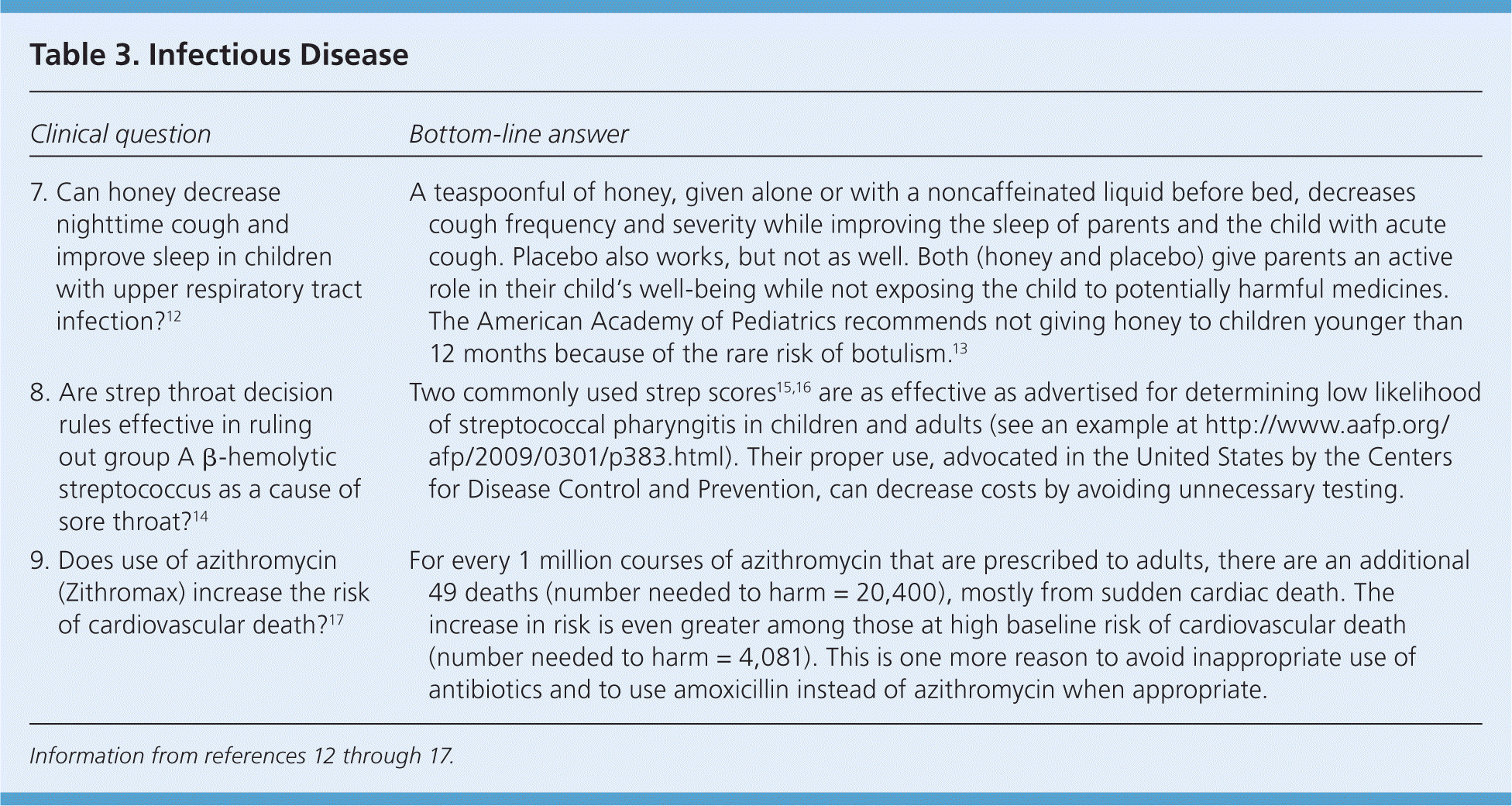
| Clinical question | Bottom-line answer |
|---|---|
| 7. Can honey decrease nighttime cough and improve sleep in children with upper respiratory tract infection?12 | A teaspoonful of honey, given alone or with a noncaffeinated liquid before bed, decreases cough frequency and severity while improving the sleep of parents and the child with acute cough. Placebo also works, but not as well. Both (honey and placebo) give parents an active role in their child's well-being while not exposing the child to potentially harmful medicines. The American Academy of Pediatrics recommends not giving honey to children younger than 12 months because of the rare risk of botulism.13 |
| 8. Are strep throat decision rules effective in ruling out group A ß-hemolytic streptococcus as a cause of sore throat?14 | Two commonly used strep scores15,16 are as effective as advertised for determining low likelihood of streptococcal pharyngitis in children and adults (see an example at https://www.aafp.org/afp/2009/0301/p383.html). Their proper use, advocated in the United States by the Centers for Disease Control and Prevention, can decrease costs by avoiding unnecessary testing. |
| 9. Does use of azithromycin (Zithromax) increase the risk of cardiovascular death?17 | For every 1 million courses of azithromycin that are prescribed to adults, there are an additional 49 deaths (number needed to harm = 20,400), mostly from sudden cardiac death. The increase in risk is even greater among those at high baseline risk of cardiovascular death (number needed to harm = 4,081). This is one more reason to avoid inappropriate use of antibiotics and to use amoxicillin instead of azithromycin when appropriate. |
The authors of study 7 (Table 312–17 ) found that a little honey decreases the frequency of cough in children between one and five years of age, and helps parents and children sleep better. Additionally, it is safer than over-the-counter cold preparations.12 Clinical decision rules can help physicians focus the history and physical examination on what really matters. For patients with sore throat, a strep score instructs physicians to assess for fever, adenopathy, exudates, and absence of cough. Study 8 indicates that using a score can help decrease costs without adversely affecting the quality of care.14
Macrolide antibiotics have long been known to increase the QT interval in some patients, rarely leading to arrhythmia and cardiac death. Study 9 used data from a large Medicaid database that linked information about prescriptions for azithromycin (Zithromax) with episodes of cardiovascular death, sudden cardiac death, and all-cause mortality. Adults given azithromycin were matched with four patients who did not receive an antibiotic or who received an alternative antibiotic. Although there is only a small increase in the risk of death, many prescriptions for azithromycin are unnecessarily given for viral respiratory tract infections, making any serious adverse effects caused by this drug particularly unacceptable.17
Musculoskeletal Disease and Exercise
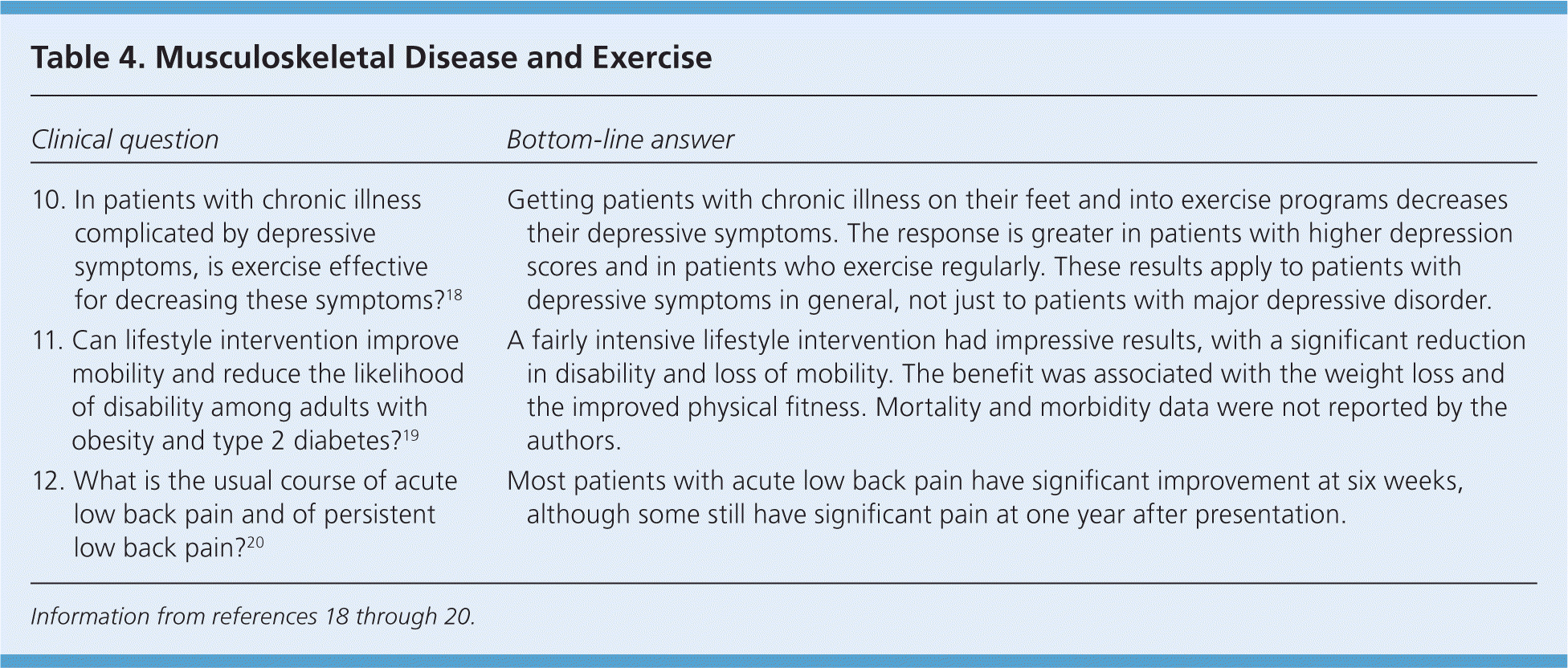
| Clinical question | Bottom-line answer |
|---|---|
| 10. In patients with chronic illness complicated by depressive symptoms, is exercise effective for decreasing these symptoms?18 | Getting patients with chronic illness on their feet and into exercise programs decreases their depressive symptoms. The response is greater in patients with higher depression scores and in patients who exercise regularly. These results apply to patients with depressive symptoms in general, not just to patients with major depressive disorder. |
| 11. Can lifestyle intervention improve mobility and reduce the likelihood of disability among adults with obesity and type 2 diabetes?19 | A fairly intensive lifestyle intervention had impressive results, with a significant reduction in disability and loss of mobility. The benefit was associated with the weight loss and the improved physical fitness. Mortality and morbidity data were not reported by the authors. |
| 12. What is the usual course of acute low back pain and of persistent low back pain?20 | Most patients with acute low back pain have significant improvement at six weeks, although some still have significant pain at one year after presentation. |
The value of exercise and lifestyle interventions is often underestimated. Studies 10 and 11 (Table 418–20 ) demonstrate that even modest exercise can reduce morbidity and mortality, and improve symptoms of depression. Study 10 is a systematic review of 90 studies comparing exercise with nonexercise treatment in patients with chronic disease and depression. Benefit was greatest in patients with higher depression scores, but occurred in any patient with depressive symptoms.18 Study 11 randomized patients with obesity and type 2 diabetes who were 45 to 74 years of age to either usual care or a lifestyle intervention consisting of portion control, group meetings, and encouragement to exercise. The researchers found that the number needed to treat to achieve good mobility was 18, and to avoid severe disability was 16.19
Study 12 systematically reviewed the literature, identifying high-quality cohort studies of patients with back pain. For patients with acute or subacute back pain (duration of less than 12 weeks), the pain score decreased from 69 at baseline to 28 at six weeks and to 4 at one year. Disability scores decreased from 57 at baseline to 28 at six weeks and to 11 at one year. For patients with persistent back pain (duration of 12 weeks to 12 months), disability scores were 51 at baseline, 28 at six weeks, and 15 at one year.20 This study implies that physicians should treat back pain with watchful waiting for at least six weeks, and reassure patients that they will likely experience decreased pain and improved function over time.
Cancer Screening
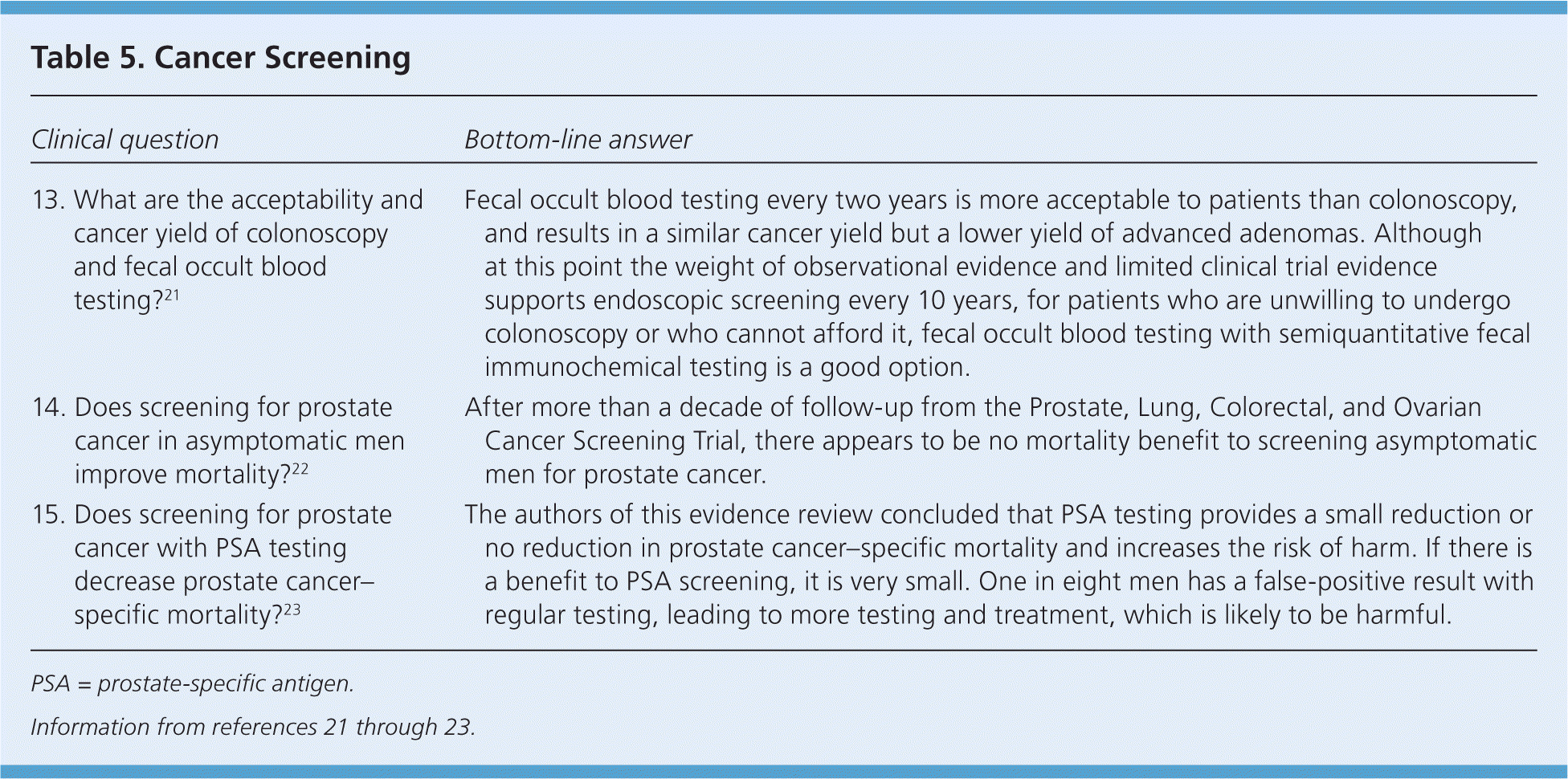
| Clinical question | Bottom-line answer |
|---|---|
| 13. What are the acceptability and cancer yield of colonoscopy and fecal occult blood testing?21 | Fecal occult blood testing every two years is more acceptable to patients than colonoscopy, and results in a similar cancer yield but a lower yield of advanced adenomas. Although at this point the weight of observational evidence and limited clinical trial evidence supports endoscopic screening every 10 years, for patients who are unwilling to undergo colonoscopy or who cannot afford it, fecal occult blood testing with semiquantitative fecal immunochemical testing is a good option. |
| 14. Does screening for prostate cancer in asymptomatic men improve mortality?22 | After more than a decade of follow-up from the Prostate, Lung, Colorectal, and Ovarian Cancer Screening Trial, there appears to be no mortality benefit to screening asymptomatic men for prostate cancer. |
| 15. Does screening for prostate cancer with PSA testing decrease prostate cancer–specific mortality?23 | The authors of this evidence review concluded that PSA testing provides a small reduction or no reduction in prostate cancer–specific mortality and increases the risk of harm. If there is a benefit to PSA screening, it is very small. One in eight men has a false-positive result with regular testing, leading to more testing and treatment, which is likely to be harmful. |
Study 13 (Table 521–23 ) is the initial report of a large randomized trial of colorectal cancer screening comparing a fecal immunochemical test for blood in the stool every two years (as opposed to the guaiac test) with colonoscopy.21 The participation rate was higher for fecal immunochemical testing than for colonoscopy (34% vs. 25%), but the yield of advanced adenomas was higher for colonoscopy (1.9% vs. 0.9%). Testing the stool for blood (and not using a rectal examination) remains an important option for colorectal cancer screening.
Articles about prostate cancer screening remain of great interest to primary care physicians. Study 14 is a report from the Prostate, Lung, Colorectal, and Ovarian (PLCO) Cancer Screening Trial22 and study 15 is a systematic review of the world's literature on the topic.23 The PLCO Cancer Screening Trial was complicated by a fairly high rate of screening in the control group, but found increased prostate cancer–specific mortality in the group invited to receive screening.22 The systematic review, which also included a large European study, found that there is, at best, a small reduction (about one per 1,000 men screened) in prostate cancer–specific mortality in men 55 to 69 years of age who receive prostate-specific antigen screening. There is an attendant harm of more than 100 men who are diagnosed with and treated for prostate cancer, and several dozen men who experience incontinence, erectile dysfunction, or both.23 The most recent guidelines from the U.S. Preventive Services Task Force recommend against the use of prostate-specific antigen testing for screening in men of any age.24
Women's Health
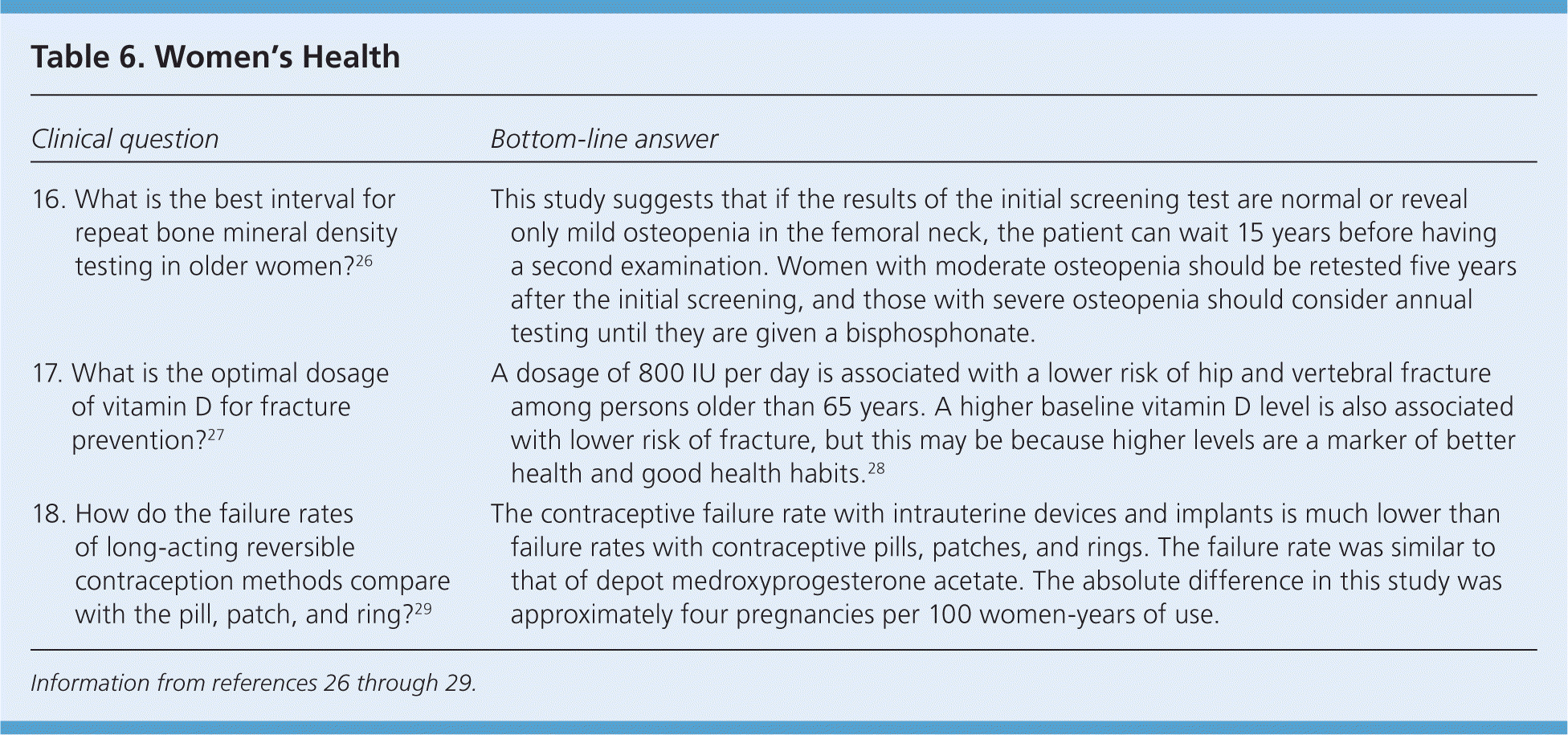
| Clinical question | Bottom-line answer |
|---|---|
| 16. What is the best interval for repeat bone mineral density testing in older women?26 | This study suggests that if the results of the initial screening test are normal or reveal only mild osteopenia in the femoral neck, the patient can wait 15 years before having a second examination. Women with moderate osteopenia should be retested five years after the initial screening, and those with severe osteopenia should consider annual testing until they are given a bisphosphonate. |
| 17. What is the optimal dosage of vitamin D for fracture prevention?27 | A dosage of 800 IU per day is associated with a lower risk of hip and vertebral fracture among persons older than 65 years. A higher baseline vitamin D level is also associated with lower risk of fracture, but this may be because higher levels are a marker of better health and good health habits.28 |
| 18. How do the failure rates of long-acting reversible contraception methods compare with the pill, patch, and ring?29 | The contraceptive failure rate with intrauterine devices and implants is much lower than failure rates with contraceptive pills, patches, and rings. The failure rate was similar to that of depot medroxyprogesterone acetate. The absolute difference in this study was approximately four pregnancies per 100 women-years of use. |
The U.S. Preventive Services Task Force recommends that women 65 years or older, and women who have a risk of fracture similar to or greater than that of a 65-year-old woman, should be screened for osteoporosis. However, an interval for subsequent screening is not specified.25 Study 16 (Table 626–29 ) provides evidence-based guidance on the optimal interval, depending on the results of the initial screening. Women with a normal examination result or only mild osteopenia can wait 15 years between screenings, whereas those with moderate osteopenia should be retested in five years, and those with severe osteopenia should be tested annually.26 After a patient starts taking a bisphosphonate, though, surveillance bone density tests are of no proven benefit. Study 17 is a systematic review of patient-level data with more than 30,000 persons taking vitamin D. The only statistically significant reduction in the risk of hip or nonvertebral fracture was among patients taking 800 IU or more of vitamin D per day.27
Study 18 is a prospective cohort study that examined unplanned pregnancy rates in women using contraception. The researchers found that unplanned pregnancy rates with intrauterine devices and implants were less than 1%, compared with 5% to 9% for the contraceptive pill, patch, or ring.29
Miscellaneous
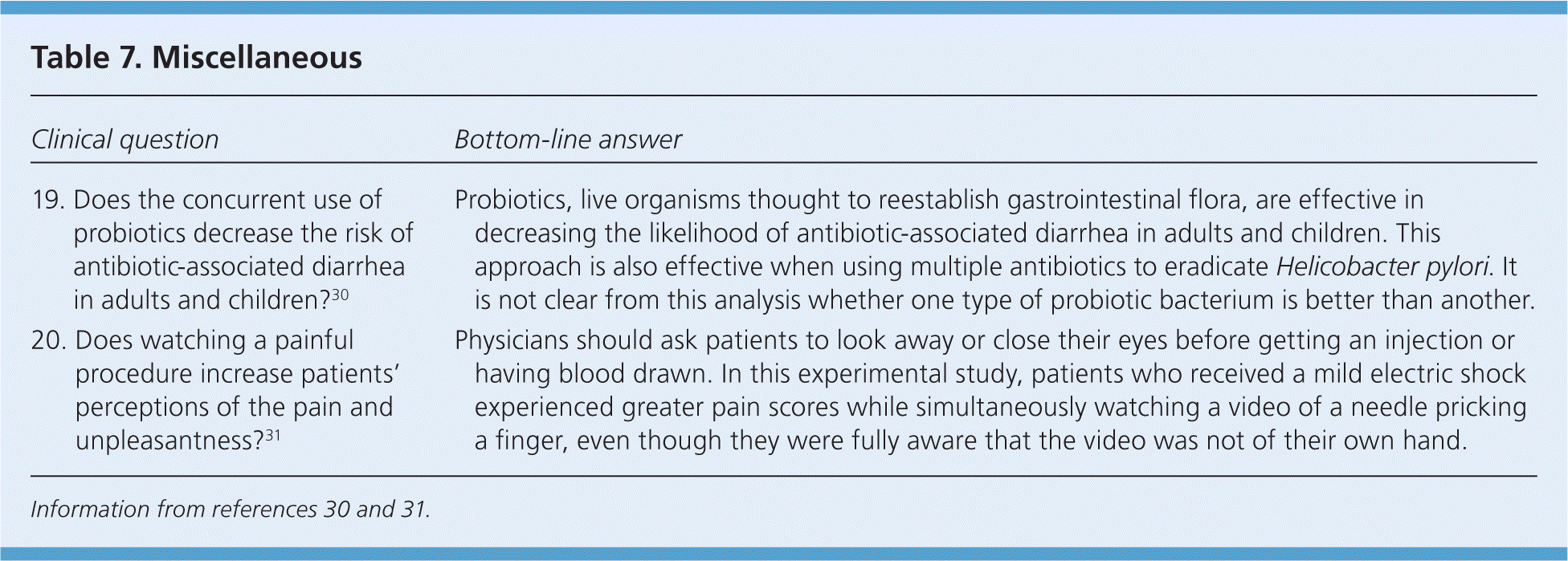
| Clinical question | Bottom-line answer |
|---|---|
| 19. Does the concurrent use of probiotics decrease the risk of antibiotic-associated diarrhea in adults and children?30 | Probiotics, live organisms thought to reestablish gastrointestinal flora, are effective in decreasing the likelihood of antibiotic-associated diarrhea in adults and children. This approach is also effective when using multiple antibiotics to eradicate Helicobacter pylori. It is not clear from this analysis whether one type of probiotic bacterium is better than another. |
| 20. Does watching a painful procedure increase patients' perceptions of the pain and unpleasantness?31 | Physicians should ask patients to look away or close their eyes before getting an injection or having blood drawn. In this experimental study, patients who received a mild electric shock experienced greater pain scores while simultaneously watching a video of a needle pricking a finger, even though they were fully aware that the video was not of their own hand. |
These two POEMs do not fit well into the other categories. Study 19 (Table 730,31 ) is a meta-analysis of 34 randomized trials with more than 3,000 patients that compared probiotics with placebo for the prevention of antibiotic-associated diarrhea. The study found a similar benefit from probiotics for adults and children, with a number needed to treat of about 8.30 Study 20 answers the question: Does it hurt more to watch an injection? This clinical trial found that the pain patients experienced from an electric shock was higher when they watched a video of a needle pricking a finger. Physicians should tell patients to just look away.31
Final Comments
A few themes emerge from these 20 research studies. One is that there is value and efficiency in taking a patient-centered approach to care. Treating low-risk patients as aggressively as high-risk patients is inappropriate, and may be harmful. Whether we are talking about control of blood glucose levels,5–7 cardiovascular prevention,8–10 or the interval for osteoporosis screening,26 sometimes less testing or less treatment can be better for our patients. It is worth examining the Choosing Wisely campaign, which provides a long list of evidence-based recommendations for more efficient care, with contributions from the American Academy of Family Physicians and other specialty societies (http://www.choosingwisely.org). An editorial about the Choosing Wisely campaign, including a table of primary care–relevant recommendations, is available in American Family Physician at https://www.aafp.org/afp/choosingwisely.
EDITOR'S NOTE: This article was cowritten by Dr. Mark Ebell who is a member of the U.S. Preventive Services Task Force, deputy editor for American Family Physician (AFP), and cofounder and editor-in-chief of Essential Evidence Plus, published by Wiley-Blackwell.
Because of Dr. Ebell's dual roles and ties to Essential Evidence Plus, the concept for this article was independently reviewed and approved by a group of AFP's medical editors. In addition, the article underwent peer review and editing by four of AFP's medical editors. Dr. Ebell was not involved in the editorial decision-making process.—JAY SIWEK, MD, Editor, American Family Physician
